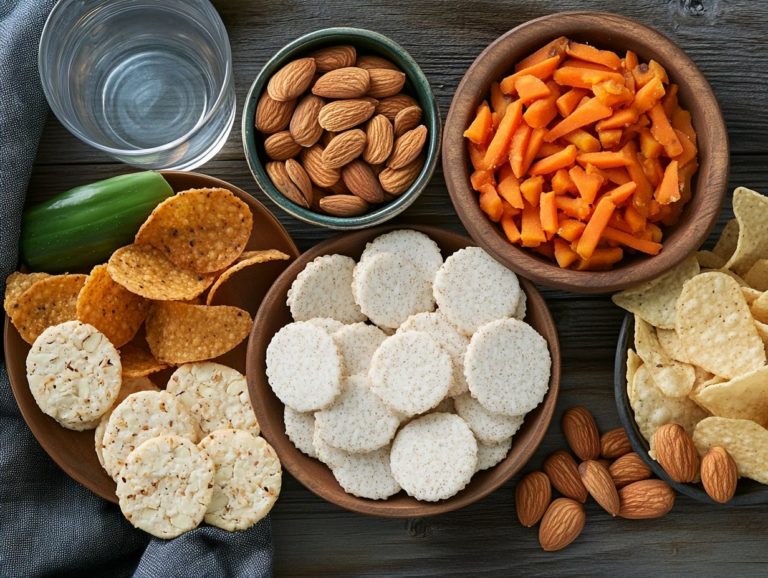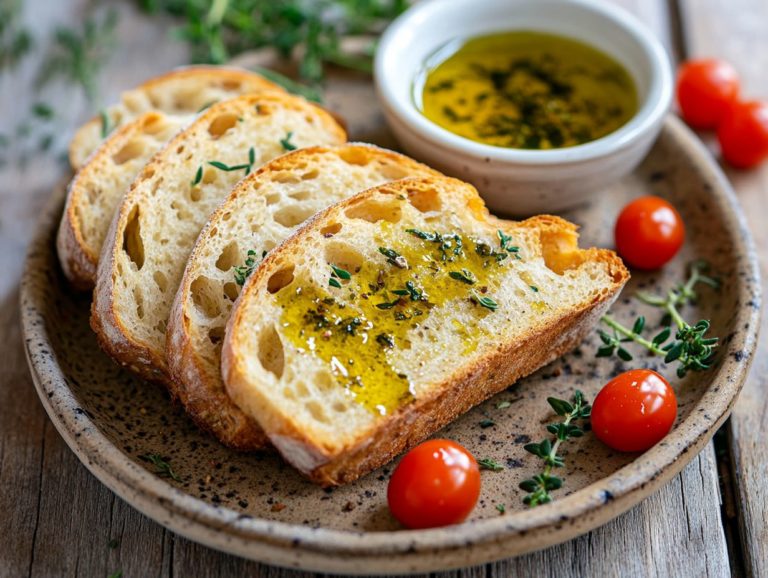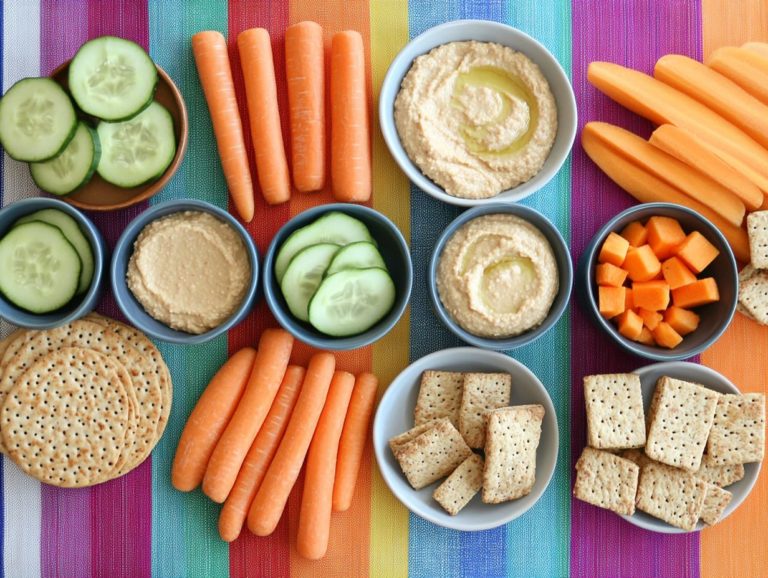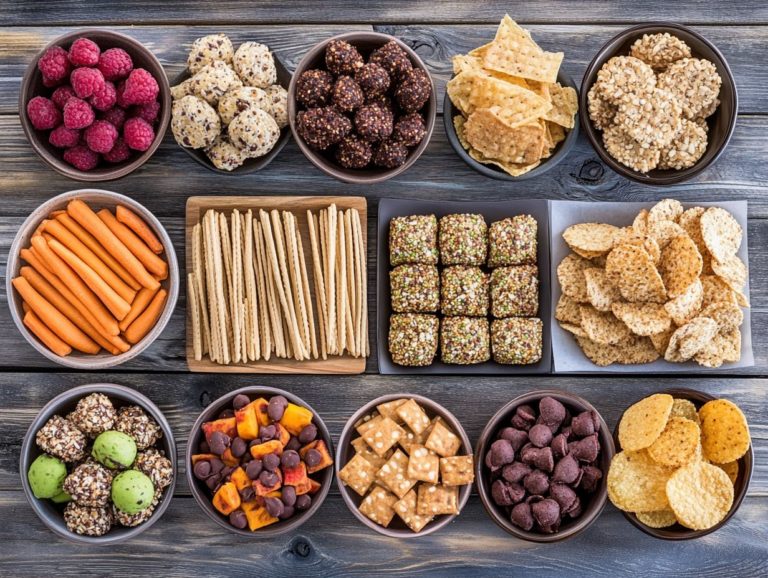What Is the Difference Between Gluten-Free and Wheat-Free?
Navigating dietary choices can feel like wandering through a maze, particularly when it comes to gluten-free and wheat-free options, especially for those with conditions like celiac disease or gluten intolerance.
While these two diets may appear similar at first glance, they cater to distinct health needs and lifestyles, including those with autoimmune diseases like Crohn’s disease and celiac disease. Let’s explore the essentials together, shedding light on what gluten is, its effects on your body, and how it differs from wheat.
You ll gain clarity on the key distinctions between gluten-free and wheat-free diets, who should consider these options, and practical tips for successfully following them. Discover the nuances that will empower you to make informed choices for your health and nutrition!
Contents
- Key Takeaways:
- What Is Gluten-Free?
- What Is Wheat-Free?
- Who Should Follow a Gluten-Free or Wheat-Free Diet?
- 1. Celiac Disease
- 2. Non-Celiac Gluten Sensitivity
- 3. Wheat Allergy
- Comparison of Gluten-Free and Wheat-Free Diets
- How to Follow a Gluten-Free or Wheat-Free Diet?
- Navigating a Gluten-Free and Wheat-Free Lifestyle
Key Takeaways:
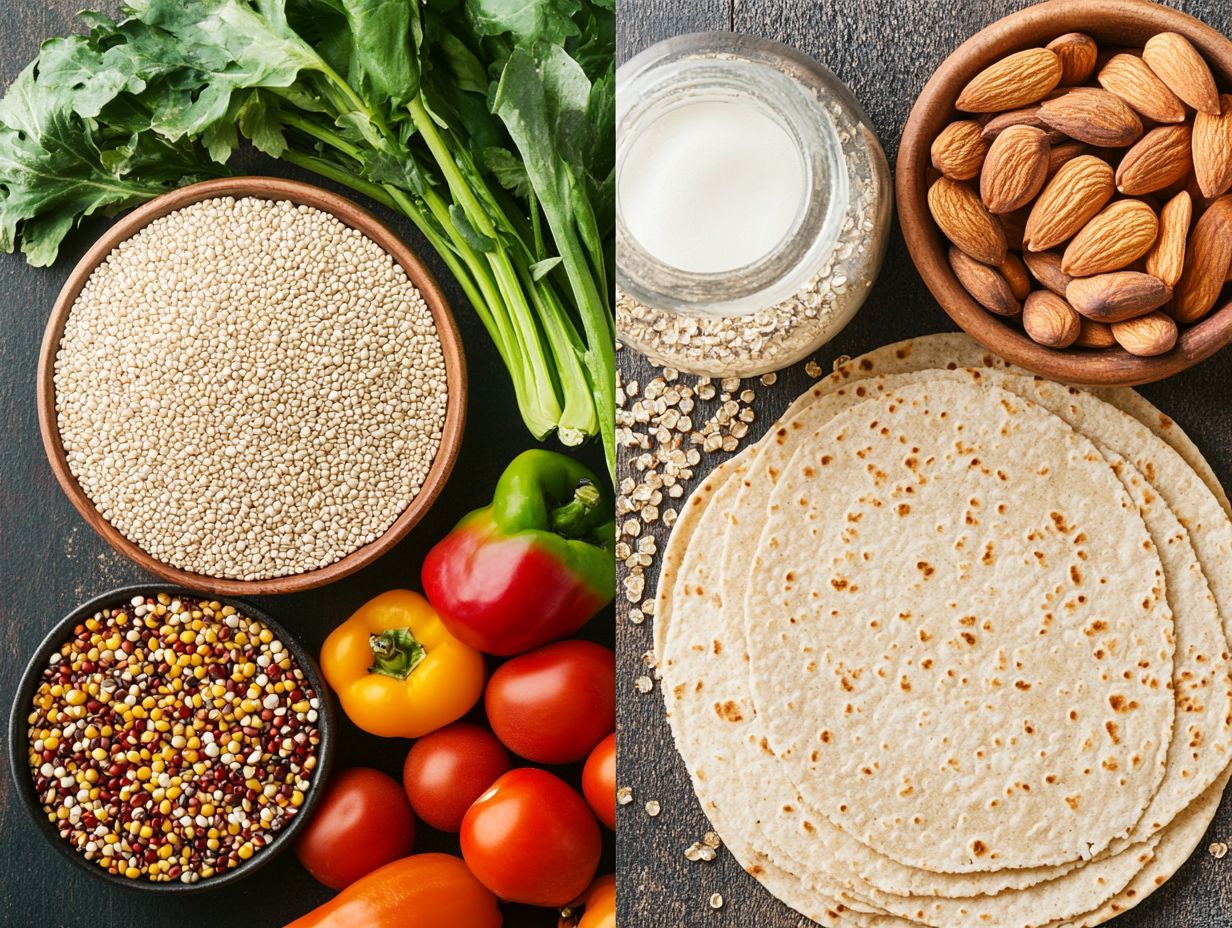
- Gluten-free and wheat-free diets are not the same. While both exclude wheat, gluten-free diets also eliminate other gluten-containing grains like barley and rye, whereas wheat-free diets may still contain gluten from other sources.
- The primary difference lies in health needs: Gluten-free diets are essential for celiac disease, while many opt for wheat-free diets due to allergies or sensitivities.
- It is important to consult a healthcare professional before starting a gluten-free or wheat-free diet to ensure proper nutrition and to rule out any underlying health conditions. Reading labels, cooking at home, and finding alternatives are key steps to successfully following these diets.
What Is Gluten-Free?
Gluten-free refers to a dietary approach that excludes gluten, a protein primarily found in wheat, barley, and rye. For individuals with gluten intolerance or celiac disease, consuming gluten can lead to severe reactions, including digestive issues and symptoms of celiac disease.
This dietary choice has gained popularity among health-conscious individuals like yourself, not only for alleviating symptoms associated with gluten sensitivity but also for promoting the consumption of naturally gluten-free foods such as legumes, quinoa, rice, and an array of vegetables, including gluten-free alternatives like chickpeas and flaxseeds.
Following a gluten-free diet is crucial for managing conditions like celiac disease, a serious autoimmune disorder that requires a strict gluten-free diet, as it causes harm to the small intestine when gluten is ingested.
What Is Gluten and How Does It Affect the Body?
Gluten is a composite protein predominantly found in wheat, barley, and rye, and it plays an essential role in providing elasticity to dough, allowing it to rise and hold its shape. For many, gluten is perfectly harmless and can seamlessly fit into a balanced diet. However, for those with celiac disease or gluten intolerance, consuming gluten can unleash a host of digestive issues and autoimmune reactions that profoundly affect their health and overall well-being.
These health challenges emerge when the immune system mistakenly perceives gluten as a threat, resulting in inflammation and damage within the small intestine for individuals with celiac disease. Common symptoms include bloating, diarrhea, fatigue, and even neurological issues.
People with gluten sensitivity may encounter gastrointestinal discomfort, headaches, and joint pain, albeit without the accompanying autoimmune response. Understanding the biological role of gluten and its potential ramifications for sensitive individuals is crucial for cultivating a healthier lifestyle, necessitating thoughtful dietary choices to prevent adverse reactions.
What Is Wheat-Free?
A wheat-free diet requires you to eliminate wheat and wheat-based products from your meals. This means saying goodbye not just to obvious culprits like bread, pasta, and cereals, but also to hidden ingredients such as wheat starch lurking in processed foods.
For those with wheat allergies or intolerances, this dietary choice is crucial; it helps avoid adverse reactions and fosters improved digestive health. By embracing wheat-free alternatives think gluten-free grains like quinoa, rice, and legumes you can enjoy a nutritious and diverse diet without sacrificing flavor.
What Is Wheat and How Does It Differ from Gluten?
Wheat is a cereal grain that stands out as one of the most extensively cultivated food crops in the world. It serves as a staple in countless diets thanks to its remarkable versatility and abundant carbohydrate content.
Wheat is not just a source of energy. It is also important in many food products, from bread and pasta to breakfast cereals. It’s essential to differentiate between gluten a composite of proteins that contributes to elasticity and chewiness and wheat as a whole, especially for those with dietary restrictions.
While many savor the nutritional benefits of wheat, individuals who require gluten-free or wheat-free diets must be diligent in selecting alternatives to avoid gluten-related reactions. Knowing these differences can empower you to make better food choices quickly!
What Are the Differences Between Gluten-Free and Wheat-Free Diets?
The distinctions between gluten-free and wheat-free diets are substantial and tailored to meet specific health requirements. A gluten-free diet eliminates all sources of gluten including wheat, barley, and rye.
In contrast, a wheat-free diet restricts only wheat products, allowing room for naturally gluten-free grains like rice, oats, and quinoa. Grasping these differences is crucial for anyone dealing with gluten intolerance, celiac disease, or wheat allergies, as it directly influences their food selections and nutritional needs.
Following either diet means you need to read food labels carefully. Thoughtful meal planning is essential to ensure you achieve adequate nutrition while steering clear of any unwanted reactions.
1. Intolerance vs. Allergy
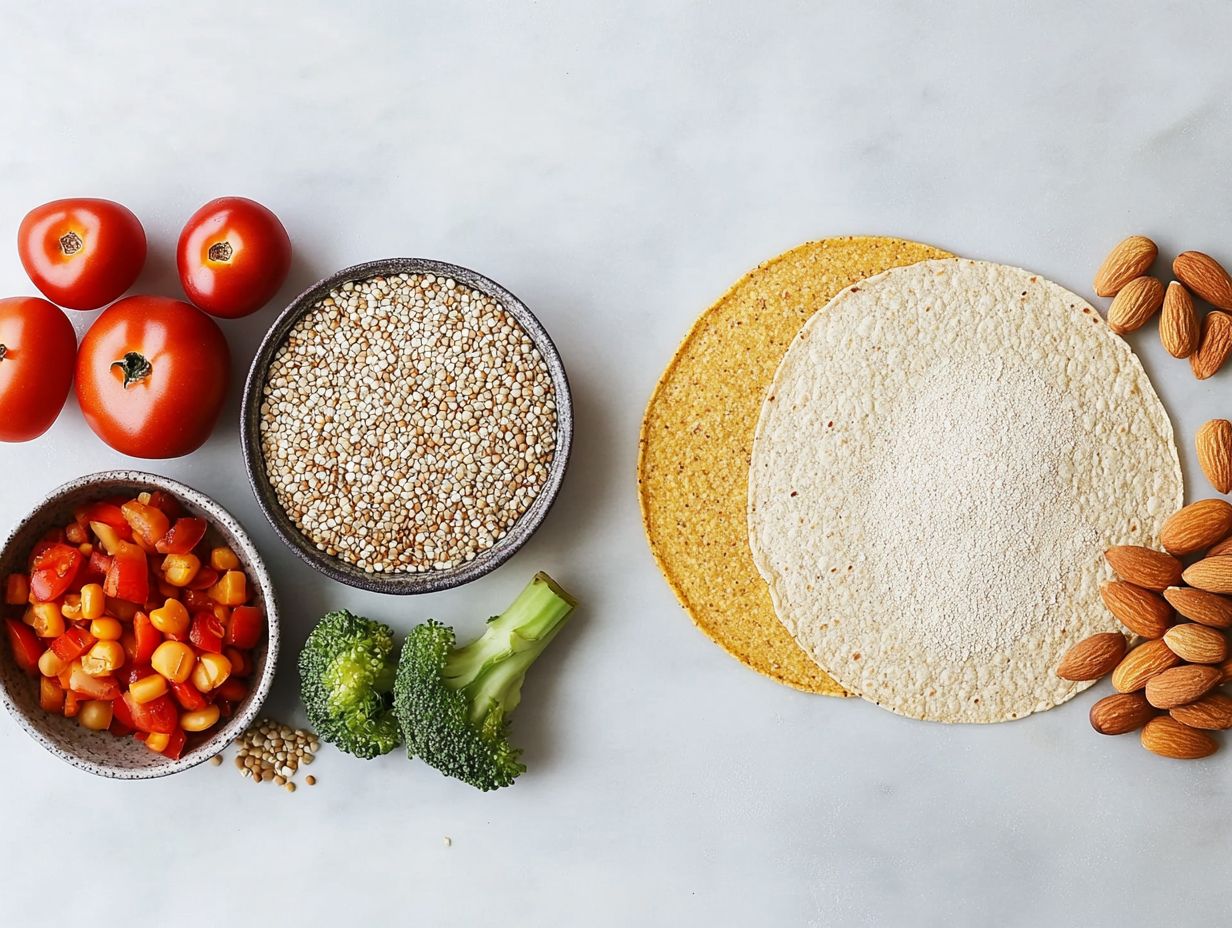
Understanding the distinction between intolerance and allergy is vital for anyone navigating dietary restrictions. Gluten intolerance refers to a non-allergic sensitivity that can result in various digestive symptoms. In contrast, a wheat allergy triggers an immune response that can lead to severe reactions upon exposure to wheat.
These two conditions require different strategies for dietary management and can significantly influence your health and lifestyle. Symptoms of gluten intolerance often include:
- Bloating
- Fatigue
- Digestive issues
Wheat allergy symptoms can range from hives to anaphylactic shock (a severe, life-threatening allergic reaction), making it essential to be aware of the differences.
Recognizing these distinctions is key for appropriate treatment and effective lifestyle adjustments. Gluten intolerance often develops gradually, leading to inconsistent symptom severity, which can complicate diagnosis. Conversely, wheat allergies often manifest with immediate and potentially life-threatening reactions, necessitating swift intervention.
To manage gluten intolerance, you might find relief through a gluten-free diet. Those with a wheat allergy, however, must adhere strictly to avoiding wheat in all forms, as even trace amounts can trigger serious reactions.
Consulting with healthcare providers for proper testing and personalized dietary advice is critical if you’re experiencing symptoms related to either condition. Organizations such as the Coeliac Society and regulatory bodies like the US FDA can provide additional resources and guidance.
In conclusion, understanding the differences between gluten intolerance and wheat allergies is essential for making informed dietary choices. Stay vigilant and consult healthcare professionals to ensure your health and well-being.
2. Sources of Gluten and Wheat
The sources of gluten and wheat are surprisingly diverse, presenting a range of challenges for those grappling with gluten intolerance or wheat allergies. Gluten primarily lurks in wheat, barley, rye, and spelt. It often hides in everyday staples like bread, pasta, and many processed foods.
With products such as flour and wheat starch frequently appearing in countless recipes and packaged items, it becomes imperative for you to be diligent about carefully checking food labels when choosing your meals to avoid unexpected gluten exposure.
This vigilance extends beyond the usual suspects like baked goods and cereals. Even sauces, dressings, and certain snacks can harbor hidden gluten, complicating your dietary journey. Familiarizing yourself with alternative grains like quinoa, rice, or oats (the gluten-free kind, of course) can help you maintain a nutritional balance while steering clear of gluten.
Remember, gluten-free doesn t automatically mean healthier! You ll want to pay attention to additives, nutritional supplements, and fiber content as well. By prioritizing label reading and exploring gluten-free options, you can elevate your meal experiences without compromising your health.
3. Nutritional Differences
Nutritional differences between gluten-free and wheat-free diets can significantly impact your overall health and wellness. While gluten-free diets typically rely on alternative grains and products, wheat-free diets might still include gluten-free grains such as rice, quinoa, and oats.
Understanding these distinctions is crucial if you need to adhere to these diets for health reasons, ensuring you receive adequate nutrition from your food choices. Incorporating a variety of vegetables, legumes, and gluten-free alternatives will help maintain a balanced diet.
Navigate these dietary paths by diversifying your food sources beyond just grains like barley, rye, and oats. Including nutrient-dense options like beans, lentils, and seeds enhances your intake of protein and essential vitamins.
Fruits and vegetables, along with legumes like chickpeas, should take center stage in your meals, providing necessary antioxidants and fiber. Explore gluten-free grains like millet and amaranth for a varied diet!
Ultimately, understanding the broader landscape of available foods will empower you to design strength-focused eating habits that cater to your unique needs.
Who Should Follow a Gluten-Free or Wheat-Free Diet?
You should consider a gluten-free or wheat-free diet if you ve been diagnosed with celiac disease, non-celiac gluten sensitivity, or a wheat allergy. These conditions require meticulous dietary management to avoid any adverse health effects and intolerances.
Celiac disease is an autoimmune disorder that demands complete elimination of gluten-containing foods to prevent serious damage to your intestines. If you have gluten sensitivity, you might experience discomfort from gluten, although you don t have the same autoimmune response as those with celiac disease.
Meanwhile, a wheat allergy can trigger severe reactions, making it crucial for you to manage your diet carefully to ensure your safety.
1. Celiac Disease
Celiac disease is a serious condition where the body attacks itself when gluten is consumed. It wreaks havoc on the small intestine, leading to symptoms that can severely impact your quality of life. You might experience abdominal pain, bloating, diarrhea, and fatigue.
If you’re diagnosed with celiac disease, adhering to a strict gluten-free diet is essential. This helps prevent further health complications and promotes healing in your gut.
Understanding food labels and ingredient sourcing is critical to avoid all gluten-containing foods, including grains like barley and wheat starch.
The diagnostic process usually involves blood tests and might also require a biopsy (a small sample of tissue taken for testing) to confirm intestinal damage. It’s crucial for anyone suspecting they may have celiac disease to seek medical advice without delay.
Committing to a gluten-free lifestyle significantly enhances your health and lowers the risks of complications, including osteoporosis and certain cancers.
Adapting to this new lifestyle can feel overwhelming at first. This highlights the importance of educating yourself about your dietary options. By mastering the skill of reading labels and identifying safe food choices, you empower yourself to maintain your health and enjoy a varied diet, ultimately enriching your quality of life.
2. Non-Celiac Gluten Sensitivity
Non-celiac gluten sensitivity is a condition where you may experience symptoms related to gluten consumption without the formal diagnosis of celiac disease. This can lead to discomfort, manifesting as bloating, abdominal pain, and fatigue after consuming gluten-containing foods.
While the exact mechanisms behind non-celiac gluten sensitivity are still unclear, many find that embracing a gluten-free diet often brings much-needed relief, enhancing their overall health and quality of life.
Unlike celiac disease, there isn t a specific diagnostic test for this condition. Therefore, self-identification and careful dietary management are pivotal.
By eliminating gluten from your diet, you might discover a remarkable improvement in your well-being, experiencing fewer gastrointestinal disturbances and a boost in energy levels.
Common symptoms associated with this sensitivity include headaches, joint pain, and skin issues, which can be distressing and disrupt your daily routine.
Understanding the distinction between non-celiac gluten sensitivity and celiac disease is vital. While both conditions involve negative reactions to gluten, celiac disease is an autoimmune disorder with potentially serious long-term health implications.
For those navigating the challenges of non-celiac gluten sensitivity, consulting a healthcare professional and exploring gluten-free options can be a smart approach to managing your dietary needs and enhancing your quality of life.
3. Wheat Allergy
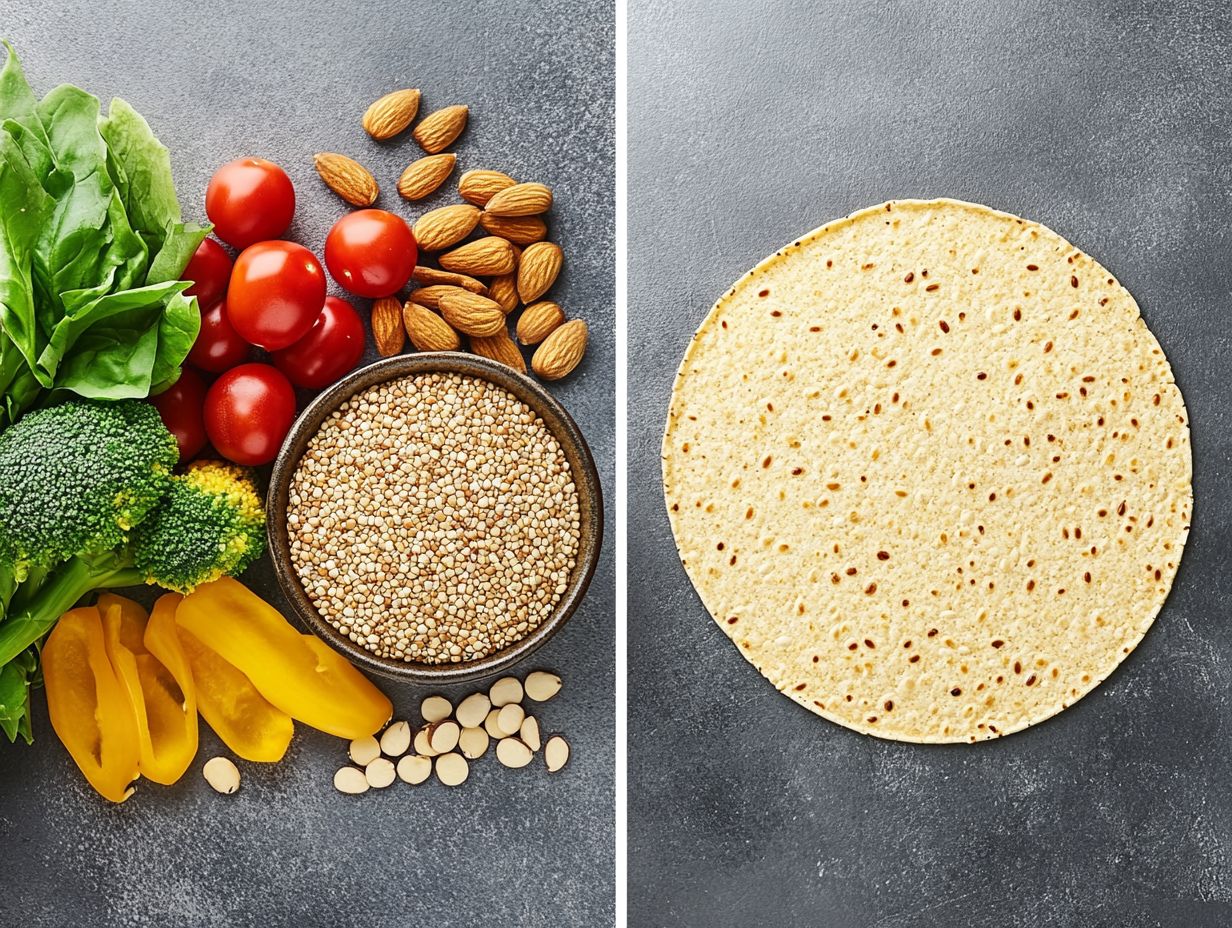
A wheat allergy is your body’s way of reacting to proteins found in wheat, unleashing a spectrum of symptoms from mild hives to severe anaphylaxis when exposed to wheat products. For anyone with this allergy, avoiding wheat and any food with wheat ingredients is a necessity.
Managing a wheat allergy requires diligence in reading labels and understanding where wheat might be hidden in your food. This underscores the importance of dietary awareness to keep allergic reactions at bay. Unlike gluten intolerance, a wheat allergy triggers immune responses that may need immediate medical intervention.
Identifying this allergy often starts with a thorough medical history, followed by skin prick tests or blood tests to confirm the presence of specific IgE antibodies to wheat proteins. Common symptoms can range from digestive issues and respiratory difficulties to skin reactions, varying significantly from person to person.
In severe cases, anaphylaxis is a risk, making it essential to carry an epinephrine auto-injector at all times.
Strict adherence to a wheat-free diet is critical for managing symptoms and avoiding potentially life-threatening reactions. This journey requires support and education about safe food alternatives, ensuring you navigate your dietary landscape with confidence and care.
Comparison of Gluten-Free and Wheat-Free Diets
The question of whether a gluten-free or wheat-free diet is healthier is undeniably subjective, hinging on your unique health conditions and dietary requirements.
Both diets can support your health when approached correctly, but they also come with potential risks of nutrient deficiencies if not thoughtfully planned. Relying heavily on processed gluten-free products might lead to a decrease in essential nutrient intake.
Conversely, choosing a wheat-free diet could open the door to a wider array of nutrient-dense foods like quinoa, rice, and legumes such as chickpeas, ultimately fostering a more balanced and healthier dietary profile for you.
1. Nutrient Deficiencies
Nutrient deficiencies can sneak into your gluten-free or wheat-free diets if you don t put some thought into your meal planning. Gluten-free diets, for instance, might miss out on essential nutrients found in whole grains think B vitamins, iron, and fiber. Similarly, a wheat-free diet with limited options can lead to similar nutritional gaps.
It s essential for you to look for nutrient-dense alternatives like:
- Legumes (like chickpeas)
- Dark leafy greens (spinach, kale)
- Nuts and seeds (chia seeds, almonds)
For those of you following these specialized diets, incorporating seeds and nuts like chia seeds, flaxseeds, and almonds can be a game changer since they are packed with omega-3 fatty acids and other vital nutrients. Dark leafy greens are also fantastic sources of iron and calcium, tackling common deficiencies head-on.
Don t forget that fortified foods and supplements can provide an additional layer of nutritional safety net for anyone who finds it challenging to meet their dietary needs through food alone. Embrace a variety of nutrient-rich foods to boost your health and ensure your meals are well-composed to significantly enhance your overall health while fully enjoying the benefits of gluten-free and wheat-free lifestyles.
2. Weight Loss
Weight loss often becomes a primary objective for those embracing either a gluten-free or wheat-free diet. However, the effectiveness and health implications can vary dramatically based on the choices you make.
For some, cutting out gluten or wheat may unintentionally lead to a reduction in calories by removing processed foods from their diet. Meanwhile, others might fall into the trap of selecting gluten-free or wheat-free processed snacks that are surprisingly high in calories. To achieve sustainable weight loss, you must focus on whole, nutrient-dense foods like vegetables, legumes, and healthy fats instead of merely relying on gluten-free or wheat-free labels.
It’s vital to understand that simply eliminating gluten or wheat from your diet does not automatically translate to weight loss. In fact, many gluten-free products on the market can be deceptively loaded with sugars and unhealthy fats, potentially negating any benefits you might expect from avoiding gluten or wheat.
This reality highlights the importance of mindful eating; prioritize nutrient-rich foods over convenient options. If your body tolerates them, consider incorporating a variety of whole grains, as they can provide essential fiber and nutrients that promote satiety and contribute to your overall health and successful weight management.
How to Follow a Gluten-Free or Wheat-Free Diet?
Adhering to a gluten-free or wheat-free diet demands a thoughtful approach and a keen eye for detail when choosing food options that align with your dietary needs. This means being meticulous about reading food labels, deciphering ingredient lists, and pinpointing safe alternatives to gluten-containing and wheat-based products.
By diving into gluten-free grains, legumes, and a vibrant array of vegetables, you can elevate your meal planning and craft delightful dishes that also support your overall health and well-being.
Mastering proper cooking techniques is important in ensuring a safe and enjoyable dining experience. Start your journey today by choosing whole, nutrient-rich foods and planning your meals wisely!
1. Reading Labels
Reading labels is an essential skill for anyone following a gluten-free or wheat-free diet. This practice gives you the power to identify hidden sources of gluten and wheat in processed foods. It involves carefully looking at ingredient lists for common allergens and terms like wheat starch, barley, and rye to avoid any adverse health reactions.
It s wise to seek out certified gluten-free or wheat-free products, ensuring you make safe choices without compromising your health. Effectively understanding how to read nutritional information can significantly enhance your shopping experience.
Remember, gluten can often lurk in unexpected items like sauces, dressings, and even some snacks. By familiarizing yourself with commonly used terms that indicate potential gluten content, you can navigate your options more confidently. Prioritizing products that clearly state gluten-free on the packaging provides additional assurance, as many manufacturers adhere to strict guidelines.
Keeping a list of safe brands and ingredients will aid in quick decision-making, promoting a healthier and safer dietary lifestyle.
2. Cooking and Eating Out
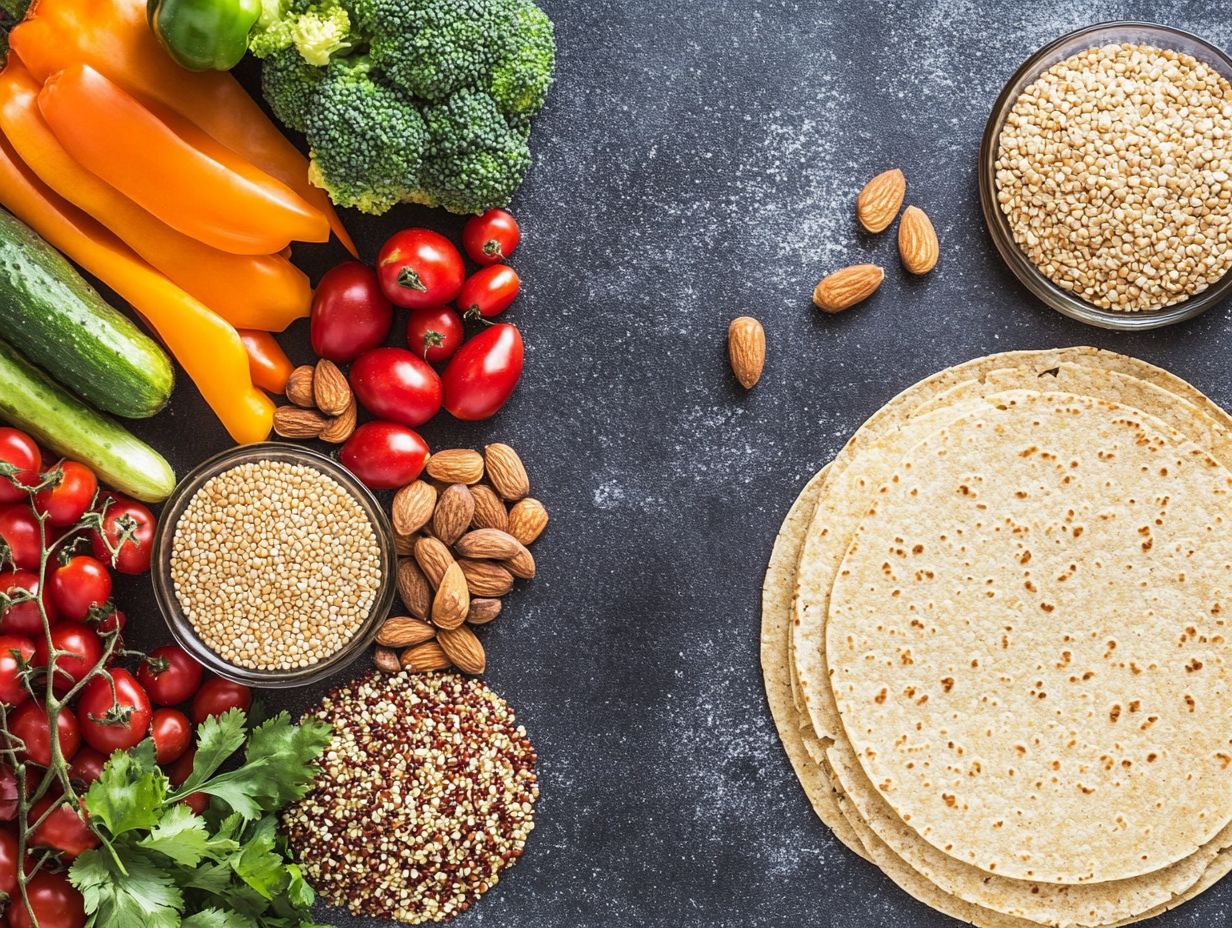
Cooking at home lets you take charge of your gluten-free or wheat-free meals, ensuring every bite is safe and delicious! You can make simple adjustments to traditional recipes by substituting wheat flour with gluten-free alternatives like almond flour or coconut flour.
When dining out, choose restaurants that specialize in gluten-free or wheat-free options; this not only ensures a safer dining experience but also expands your selection of suitable meals. These alternatives don t just provide unique flavors; they also elevate the nutritional benefits of your dishes.
In social dining situations, many establishments now offer clearly labeled dishes, and various apps can assist in locating eateries that cater to specific dietary needs. It s wise to inquire with the staff about their preparation methods, as even gluten-free items can face contamination if cooked on shared surfaces.
By planning ahead and selecting dishes that are naturally free of gluten think salads, grilled meats, and vegetable sides you can savor a hearty meal without compromising your dietary restrictions.
3. Finding Alternatives
Finding alternatives to gluten-containing and wheat-based products is essential for maintaining a balanced diet while adhering to gluten-free or wheat-free restrictions. Options like quinoa, rice, and legumes serve as excellent substitutes for traditional grains, ensuring you receive essential nutrition.
Excitingly, the market is packed with delicious gluten-free options that make snacks and meals enjoyable again! It s important for you to explore a diverse range of alternatives that not only meet your health requirements but also enhance your culinary experiences.
Ancient grains such as teff and farro, along with pseudograins like buckwheat and amaranth, are seeds that are prepared and eaten like grains, bringing interesting flavors and textures that can truly elevate your meals.
You can also discover a variety of processed gluten-free items made from almond flour, coconut flour, and chickpea flour, making it easier to whip up familiar dishes with a nutritious twist.
By incorporating this variety into your meals, you can enjoy a satisfying and nutritious diet that supports your overall well-being while respecting your dietary needs.
Frequently Asked Questions
What Is the Difference Between Gluten-Free and Wheat-Free?
Gluten-free and wheat-free are two terms that are often used interchangeably, but they actually have different meanings. Gluten-free means that a product does not contain any gluten, while wheat-free means that a product does not contain wheat.
Does Gluten-Free Mean Wheat-Free?
No, gluten-free does not necessarily mean wheat-free. Gluten is a protein found in wheat, but it can also be found in other grains such as barley and rye. A product can be gluten-free but still contain wheat.
Can You Be Allergic to Both Gluten and Wheat?
Yes, it is possible to have an allergy or intolerance to both gluten and wheat. However, they are two separate allergies and should be treated as such.
Are Gluten-Free and Wheat-Free Diets the Same?
No, a gluten-free diet and a wheat-free diet are not the same. A wheat-free diet eliminates wheat, while a gluten-free diet removes all sources of gluten, including wheat, barley, and rye.
Why Do People Follow Gluten-Free and Wheat-Free Diets?
People may follow these diets for various reasons. Some have celiac disease, a serious condition where the body cannot tolerate gluten.
Others may experience gluten intolerance or sensitivity. Many choose these diets to improve their health or meet personal dietary goals!
Is It Safe to Assume All Gluten-Free Products Are Wheat-Free?
No, it is not safe to assume that all gluten-free products are wheat-free. Always read ingredient labels and look for wheat or wheat-derived ingredients, even if a product is labeled gluten-free. Don’t risk your health always check those labels!

